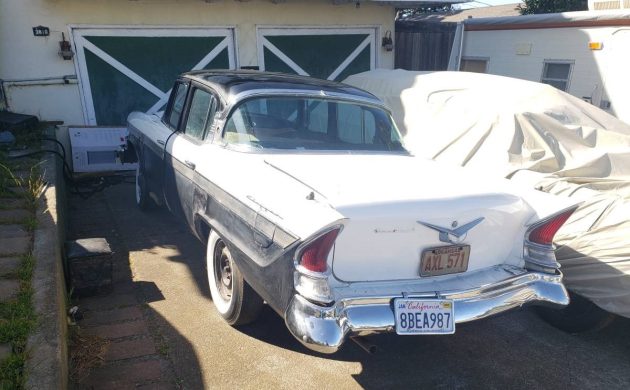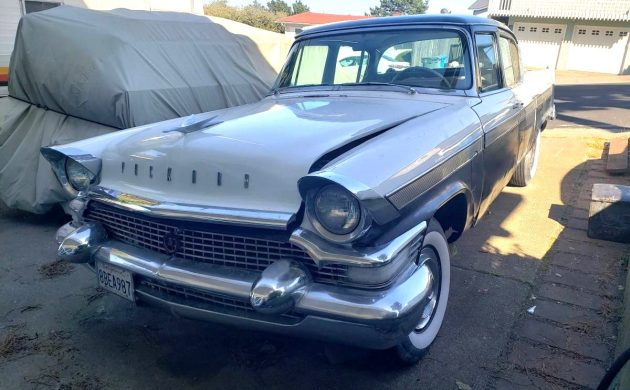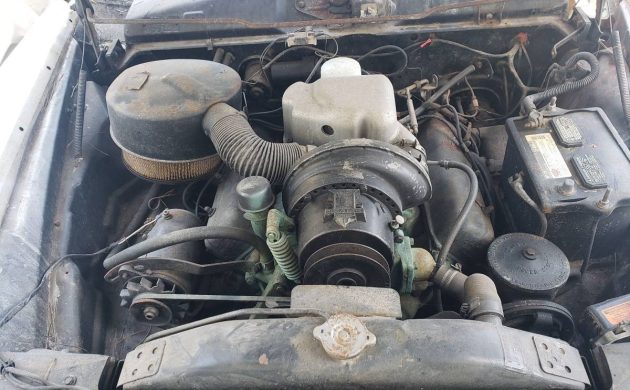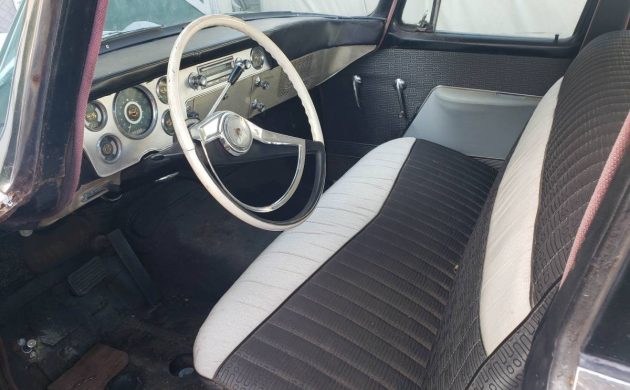Packard and Studebaker joined forces in 1954 and the product lines remained separate until 1957. That’s when the remaining Packard production became rebadged products out of South Bend, often referred to today as “Packardbakers.” Buyers and dealers alike were not impressed, sales were low, and the Packard brand would disappear after 1958. This ’57 Clipper sedan looks like a survivor that needs work – but it’s equipped with a horsepower-generating supercharger. Located in San Bruno, California, this rarity is available here on craigslist for $8,000.
The history of Packard Motor Car Co. was a storied one, dating to the turn of the 20th Century (1899). They built a reputation for producing quality, luxurious cars that would continue into the mid-1950s. After 1956, anything branded with the Packard name was a Studebaker in disguise. The changes were not popular and in 1957, only 4,800 Clippers were sold, 82% being 4-door sedans like the seller’s edition. Since Packard had closed its engine plant in ’56, the 1957 Clipper used a Studebaker 289 cubic inch V8 with a supercharger, giving the car a capable 275 hp.
This Clipper may only need some TLC, but it’s hard to tell. With just over 100,000 miles, the engine in this automobile starts right up, but the supercharger has issues. It needs to have a bearing replaced along with the belt. The car’s automatic transmission has had new seals installed, so it should be ready to go. We’re told the fuel tank has also been resealed and the Packard has a new brake master cylinder.
From the photos provided, the body, paint, chrome, and glass seem to be okay. At least good enough for weekend use. The Packardbaker has been treated to new upholstery though a new carpet set is waiting to be put in. If you like the anomaly that was the 1957-58 Packards, would you add this one to your Studebaker arsenal (if you have one)?











I sure would add this to my vast Packard collection( cough) because this was the final curtain on Americas favorite orphan, the almighty Packard. Most think, it’s a glorified Studebaker, like that’s a bad thing. I look at this car differently. Okay, it was a Studebaker, but again, Studebaker and Packard were some of the most respected makes, to me, how could a merger of the two be bad? Like Hudson/Nash to AMC. The belt less supercharger bolsters what I’ve said all along, it was a gimmick that few liked, and remorse was high. I can’t find the added cost, but seemed to add over $400 bucks, and when the belt broke due to bearing failure, as seen here, many never repaired them. Suddenly, the car ran better like when the air pump belt broke on my MGB. I say it’s still a beautiful car, and I hope someone saves this important piece of automotive history.
Howard [and other readers here],
You are correct, the 1057 Clipper was basically the high end model of the Studebaker line-up, taking the place of the President Classic.
Unlike the MGB with an air pump that was added to an engine that was never intended to use it when the engine was first designed, the supercharger on the Studebaker 289 was designed to run whenever the engine was running. Not at full boost, but at a low pressure boost. All the time. The higher boost levels didn’t happen until the solenoid on top of the supercharger housing was activated.
When the belt is disconnected, this low-pressure boost is gone, and now the airflow [under suction] has to navigate not just thru the air filter, but a bunch of turns to the supercharger, then pass through the internal air passages and impeller, then up to the carb housing and into the carb. This increases the amount of power needed for the air to navigate.
Plus, if you look at the engine photo above, you will see a round black hole in the carb cover’s aluminum housing, it’s a suction release poppet valve that’s spring loaded to close when the engine starts, and the low pressure system pressurizes the carb housing. So when the supercharger is unbelted, that hole remains open, sucking unfiltered air directly into the carb area. (1)
We had a ’58 Golden Hawk come in to the shop, and one of the complaints was the car was very hard to start when the engine was cold. The culprit was an unbelted supercharger and a black plastic plug in the carb housing, closing off the poppet valve. There was simply too much restriction in airflow when starting. We sent the supercharger out for rebuilding, popped the plastic filler plug out, and the car ran much better.
I’ve owned several supercharged Studebakers and Packards [my primary transportation in college was a ’57 Clipper like this one], and I’ve worked on many others at my shop. On the cars that came in to my shop without using a supercharger belt for years, the inside of the carb housing [and the carb] were filthy, because of ambient air bypassing the filter.
I had a black ’57 Clipper that I needed to temporarily remove the supercharger belt when the bearing on the belt tensioner pully failed. I noticed the engine had less power until I fixed the problem and installed the belt again.
(1) This pressure relief poppet valve was used on all the cars that used the Paxton & McCulloch Superchargers, including the ’54-55 Kaiser Manhattan and ’57 Thunderbirds.
Always wonder what would have happened if plan to combine Nash, Hudson, Packard and Studebaker had been successful. The 56 Packard seniors (especially Caribbean) were some of the most beautiful. The Clippers were a good upscale version of Studebaker. Would I buy one? As Packard once advertised, ASK the MAN who Owns One?
Always thought that the Packard factory location on GRAND Ave, in Detroit was appropriate since Packard was a grand old Marque building GRAND luxury vehicles. At one point, Packard led the Luxury market in sales. The South Bend Studebaker facility was unable to accommodate the large traditional Packard bodies. Guess you might call this The PELICAN Brief! 😉
Rick, To call that bird a Pelican is a capitol offence to Packard owners. It is a CORMORANT. LOL.
Lance,
Pelican or Cormorant? The answer is It’s BOTH!
The Packard family crest describes the bird as a “Pelican in it’s piety” ]pulling meat from it’s own breast to feed it’s chicks]. Cormorants originated in the far east, and were unknown in England when the Packard family crest first developed.
However the real change to Cormorant came gradually, starting with Earl C, Anthony, the HUGE Packard Dealer for LA and San Francisco. ECA advertised the bird ornament as a Cormorant, as it was seen on the West coast of America as being a very elegant bird, compared to the pelican that was perceived as a bit of a glutton and often the victim of bad jokes.
So yeah, It’s a pelican and a cormorant, but by the mid 1930s, the name caught on, and the factory started calling them a Cormorant.
The plans to combine Studebaker-Packard and Nash-Hudson together is a total myth, always has been. To learn what really happened in the years 1952-1958, I suggest one read the excellent book on James J Nance and his time as president of S-P; Spellbinder, by Stuart Blond [available on Amazon or thru the author].
Bill, thanks for confirming my comments on Nance and the now INFAMOUS Tail lights! Teague, I believe designed the cathedral lights in a single weekend under pressure from Nance! It’s great to know that memories light the corners of what’s left of my mind! At this stage of my life, I am a Vintage Rolls Canardly, I Roll down one hill and Canardly get up the next! And today (after Christmas) perhaps a turkey could serve as a cormorant, as the Tryptophan is further impeding attempts! Happy Holidays!
George Mason of Nash had long planned a merger of most of the Independents with Studebaker has the low-price leader, then Hudson and Nash, and then Packard at the top. REO would be the truck line. James Nance, fresh from Hotpoint, wanted to be the CEO; Mason said Nance would be on the board but that Mason would be president and George Romney would be vice president. At that, Nance said that Romney “wasn’t fit to carry Mason’s briefcase” and left merger negotiations but agreed to work with the new AMC on “parts reciprocity”, where Packard would sell AMC engines and buy body stampings for its cars. Packard never bought anything and insiders said it treated its sale of V8s to AMC almost as a charitable gesture.
If that merger had happened, AMC would have been bigger than Chrysler.
Merger fact or fiction? Definitely believe Romney was not a good fit for AMC. Supposedly saved the company, but many of his decisions (Gremlin, PACER, and dropping AMBASSADOR, et. al.) were dragging it further toward catastrophic end.
Lou,
The concept or idea of the big merger of Nash-Hudson and Studebaker-Packard is a long-festering myth, and the actual historical truth can be found in Stuart Blond’s book mentioned above. Stuart was friends with the Nance family, and was given total access to all of James Nance’s personal and corporate records, and it seems he recorded & kept nearly everything. There was nothing suggesting the merger.
Mason DID approach the Packard board of directors in 1950 about combining companies, but the board chose not to consider it, as Packard was awash in cash and was doing well.
No further merger discussions were ever recorded for history. The only exchange between S-P and N-H was an agreement to quote prices to make or supply various parts to each other, with Packard selling some 5,000 of it’s smaller 320 V8 to be used in the 1955 Nash & Hudson cars, however all the quotes to provide parts to S-P cam in higher than they could make themselves.
Yes, I’m certain there would have been problems with who would have been president of the company had the 2 organizations merged, as both Nance and Romney were equal forces of business leadership, but any possibility of the 4-make merger never even got close enough for the decision of who would be the top dog.
I’ve been interested in Packards for some 60 years now, and I can remember all the claims of the 4-way merger plans and why they fell apart, but I believe these “facts” came about from a total lack of evidence, until Nance spoke at a Packard Club national meet banquet, and that led to a renewed effort to sort out the truth.
As for REO, I’ve never heard of them being in the mix. Studebaker already had a successful line of trucks, from the 1/2 ton up to the larger Diesel semi-tractors, I myself just can’t se what REO would bring to the table, as their dealership network was much smaller than the combined other 4 makes.
This was nothing more than badge engineering. A travesty for the grand Packard name. Sales figures prove me correct. Its twin, the 1957 Studebaker President, was much better looking and cheaper. I would have bought neither since the new 1957 Plymouth, Dodge, DeSoto, Ford and Mercury designs left Studebaker Packard and even GM in the dust!
Not a Packard fan, eh, or you wouldn’t have written that. Studebaker was building great cars in the 50s, and calling this a fancy President is a compliment. The folks that bought these were true Packard fans. I believe Packard took a major bath on the ’55/’56, and the hand writing was on the wall. All the ’57/’58 Packards did was pad the executives pockets before their getaway. The car itself was a great car, and need I remind you of the quality control of the late 50s cars you mention. Not in South Bend.
Say what you will, but cars like this fascinate me, particularly when they contain ideas that went on to be perfected in modern cars, like the supercharger. Hope it finds a good home.
Hi Kurt, I agree, except the supercharger never had a chance. The problem was, a supercharger was just producing power at over 3,000 rpms, and on a motor that redlined at around 5,000, it didn’t do much. It’s why turbocharging became popular, as it has a wider power band and a much simpler approach to more power at lower rpms.
Ah yes the 57 Packard. This car had an unusual feature which every customizer at that time wanted. The famous Packard taillight .
Yes I know it’s a Cormorant, but couldn’t resist play on words regarding movie The Pelican Brief! Did you know that the cathedral tail lights were designed by Dick Teague when J.J. Nance told him to do something to eliminate Those Damn Bull Ball tail lights featured on Packard at the time? Guess Nance had big ones, but not enough to save Packard. Happy 🎄Holidays! 😊 🎅
Rick,
Not only was that conversation word for word, when Teague showed his taillight design for the new Senior Packards, Nance basically said to put it into production basically unchanged! He recognized how beautiful and elegant they were, while at the same time being quite formal, in keeping with the Packard name.
John Reinhart’s double taillights were quite striking in 1951, with 2 sets of taillights and FOUR internal light bulbs, blended into the trailing edge of the rear fender and topped with a chrome fin. They were no longer an “added-on” light assembly. But they should have been replaced for the 1953 model year, as automobile styling had taken off. What had been cutting-edge was now seen as stylistically obsolete 2 years later.
If it was closer , I woooould have that engine out and into my 1939 Ford truck. Yes I would.
That is a huge chunk of metal! Would it fit?
Anything can be done. DARE to be Different
Studebaker and Packard, Packardbakers. Nash and Hudson, Hash. It’s a shame they couldn’t make it. Mergers seem to work nowadays with success.
… and all the Chevriacs, Oldsmuicks, Lincurys, Plodges, DeShryslers and Mercords that get overlooked when picking on the independents.
Lou,
Don’t forget the Cadiucks and the Canadian Meteords!
HOW ABOUT…Grand Royal Regal Imperial Marquis Brougham Town Coupe de Ville Crown Victoria Fifth Avenue deElegance with coachwork by LeBaron? 🤔. Sorry, just couldn’t resist! Happy New Year! 🍸 🎆
That’s a very rare find ! That ’57 model is basically a Studebaker , but by then Packard only had one more year ,1958. Ironically , I rode in a 1956 Packard in 1976 which was the last true Packard ! My father owned two Packards ; a ’49 convertible , a ’53 model which was a huge car ! Packards were always considered luxury automobiles and were expensive to own even back in their day . Today , they are prized as collector cars and command big money when fully restored . Happy Motoring !
I know someone who has a supercharged 57 Clipper that he totalled out and he pulled the engine out of it and is currently putting it in his 78 Camaro… Dare to be different brought to a whole new level…